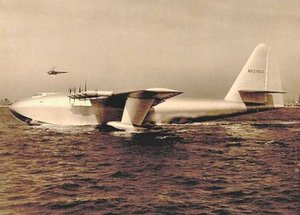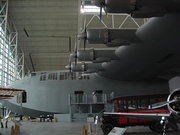|
THE SPRUCE GOOSE
|
||
|
HOME | BIOLOGY | FILMS | GEOGRAPHY | HISTORY | INDEX | INVESTORS | MUSIC | SOLAR BOATS | SPORT |
||
|
The Spruce Goose is a nickname commonly given to the Hughes H-4 Hercules, an aircraft designed and built by the Hughes Aircraft company. It is the largest flying boat, and has the largest wingspan of any aircraft ever built. Only one was built.
Due to wartime restrictions on the availability of metals, the H-4 was built almost entirely of laminated birch, not spruce as its nickname suggests. The aircraft was a marvel in its time. It married a soon-to-be outdated technology—flying boats—to a massive airframe that required some truly ingenious engineering innovations. Hughes himself detested the nickname "Spruce Goose".
Hughes H-4 Hercules
History
In 1942, the U.S. Department of War was faced with the need to transport war material and personnel to Britain. Allied shipping in the Atlantic Ocean was suffering heavy losses to German U-boats, so a requirement was issued for an aircraft that could cross the Atlantic with a large payload.
The aircraft was the brainchild of Henry J. Kaiser, who directed the Liberty ships program. He teamed with aircraft designer Howard Hughes to create what would become the largest aircraft ever built or even seriously contemplated at that time. When completed, it would be capable of carrying 750 fully-equipped troops or two Sherman tanks.
To conserve metal for the war effort, it would be built mostly of wood: hence the Spruce Goose moniker. It was also referred to as the Flying Lumberyard by critics who believed an aircraft of its size simply could not fly.
Development dragged on and was not completed until well after the war was over. In 1947, Howard Hughes was called to testify before the Senate War Investigating Committee over the usage of government funds for the aircraft, as Congress was eliminating war-era spending to free up Federal funds for domestic projects. Though he encountered skepticism and even hostility from the committee, Hughes remained unruffled. During a break in the hearings, he returned to California, ostensibly to run engine tests on the H-4. On November 2, 1947 with Howard Hughes personally at the controls, the Spruce Goose lifted off from the waters off Long Beach, remaining airborne 70 feet (20 m) off the water at a speed of 80 mph (130 km/h) for just under a mile (1.6 km). At this altitude the plane was still in ground effect and some critics believe it was too lacking in power to truly fly.
Spruce Goose at Evergreen Aviation Museum
Hughes had proved the critics wrong, but the justification for continued spending on the project was gone. Congress killed the Spruce Goose project, and the aircraft never flew again. It was carefully maintained in flying condition until Hughes's death in 1976.
In 1980 the Spruce Goose was acquired by the California Aero Club, who successfully put the aircraft on display in a large dome adjacent to the Queen Mary Exhibit in Long Beach, California. In 1988 The Walt Disney Company acquired both attractions. Unexcited by the lackluster revenue the Spruce Goose Exhibit generated, Disney began to look for another organization to take it off its hands. After a long search for a qualified buyer, the plane was acquired by the Evergreen Aviation Museum in 1993, who disassembled the aircraft and moved it by barge to its current home in McMinnville, Oregon (about an hour southwest of Portland) where it has been on display since.
Though the project was a failure, the H-4 Hercules in some senses presaged the massive transport aircraft of the late 20th century, such as the Lockheed C-5 Galaxy and the Antonov An-124 and An-225. The Spruce Goose demonstrated that the physical and aerodynamic principles which make flight possible are not limited by the size of the aircraft. Specifications
General characteristics
Performance (calculated)
External links
AVIATION A - Z
A taste for adventure capitalists
Solar Cola - a healthier alternative
|
||
|
This
website
is Copyright © 1999 & 2013 NJK. The bird |
||
|
AUTOMOTIVE | BLUEBIRD | ELECTRIC CARS | ELECTRIC CYCLES | SOLAR CARS |

